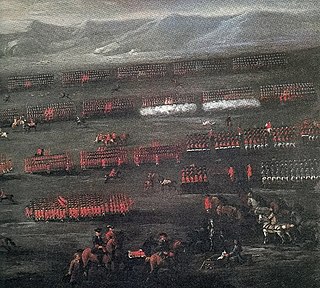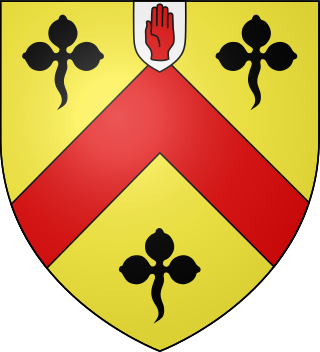
The Lord Lieutenant of Renfrewshire is the representative of the British Crown covering a lieutenancy area of the county of Renfrewshire in the west central Lowlands of Scotland.

Renfrewshire or the County of Renfrew is a historic county, registration county and lieutenancy area in the west central Lowlands of Scotland. The lieutenancy area covers the three modern council areas of Inverclyde, Renfrewshire and East Renfrewshire, and this area is occasionally termed Greater Renfrewshire to distinguish it from the modern council area called Renfrewshire. The historic county additionally included territory on the south-western edge of Glasgow which was gradually transferred to the administrative area of the city as it grew.
Renfrewshire was a county constituency of the House of Commons of the Parliament of Great Britain from 1708 until 1801 and of the Parliament of the United Kingdom from 1801 to 1885.
There have been two baronetcies created for persons with the surname Colquhoun ("Cohoon"), one in the Baronetage of Nova Scotia (1625) and one in the Baronetage of Great Britain (1786).
Sir James Campbell, 2nd Baronet of Ardkinglass, was a British Army officer and Scottish politician who sat in the Parliament of Scotland from 1703 to 1707 and in the British House of Commons from 1707 to 1741.
The Stewart, later Shaw-Stewart Baronetcy, of Greenock and Blackhall in the County of Renfrew, is a title in the Baronetage of Nova Scotia. It was created on 27 March 1667 for Archibald Stewart. In Scotland, the name is styled Shaw Stewart. This family is descended in the direct male line from Sir John Stewart, illegitimate son of Robert III of Scotland, who granted him the estate of Ardgowan in Renfrewshire. The third Baronet married Helen, sister and co-heir of Sir John Houston of that Ilk, 4th Baronet, and his wife Margaret, daughter of Sir John Shaw, of Greenock, 2nd Baronet. The fourth Baronet succeeded to the Greenock estates on the death of his great-uncle Sir John Shaw of Greenock, 3rd and last Baronet, in 1752 and assumed the additional surname of Shaw. He later sat as Member of Parliament for Renfrewshire from 1780 to 1783 and from 1786 to 1796.
Sir Michael Hugh Shaw-Stewart, 8th Baronet was a Scottish politician, soldier and landowner.
There have been two baronetcies created for members of the Reade family, both in the Baronetage of England. Both creations are now extinct.
The Maxwell, later Stirling-Maxwell, later Maxwell Macdonald Baronetcy, of Pollok in the County of Renfrew, is a title in the Baronetage of Nova Scotia. It was created on 12 April 1682 for John Maxwell, with remainder to the heirs of the body. In 1707 he was given a new patent extending the remainder to heirs of entail in his lands and estates. Maxwell was Lord Justice Clerk of Scotland from 1699 to 1702, and Rector of the University of Glasgow from 1691 to 1718.

There have been three baronetcies created for persons with the surname Meredith, one in the Baronetage of England, one in the Baronetage of Nova Scotia and one in the Baronetage of the United Kingdom. Two of the creations are extinct while one is dormant.

Ardgowan House, Castle & Gardens is a Privately owned late 18th-century mansion on the Firth of Clyde near Inverkip, Scotland. Ardgowan is located in Inverclyde, in the former county of Renfrewshire. The Ardgowan Estate has been held by the Stewart family since the early 15th century: towards the end of that century, their tower house Ardgowan Castle was built within the site of the previous Inverkip Castle fortress. The present house was erected in 1797 and completed in 1801 from designs by Cairncross. It is the seat of the Shaw Stewart baronets, currently Sir Ludovic Houston Shaw Stewart, 12th Baronet of Greenock and Blackhall.
The lands of Finnart to the west of Greenock belonged to the Earl of Douglas in medieval times. Around 1455 they were forfeited to the crown. Finnart was given to the Hamiltons, while the western part of the barony of Finnart went to Stewart of Castlemilk and became the barony of Finnart-Stewart, or Gourock.
Lieutenant General Sir John Shaw Stewart Heron-Maxwell, 4th Baronet, known as John Maxwell until 1803, was a Scottish officer in the British Army and a politician.
Before the Acts of Union 1707, the barons of the shire of Renfrew elected commissioners to represent them in the unicameral Parliament of Scotland and in the Convention of the Estates. The number of commissioners was increased from two to three in 1690.
Sir Robert Pollock, 1st Baronet, of Pollok, was a British Army officer and Scottish politician who sat in the Parliament of Scotland from 1700 to 1707 and in the British House of Commons from 1707 to 1722.

Sir John Shaw, 3rd Baronet of Greenock was a Scottish Whig politician who sat in the House of Commons between 1708 and 1734. He was instrumental in the construction of Greenock Harbour, and took part in actions against the Jacobite risings.
Sir John Houston, 3rd Baronet, of Houstoun, Renfrew, and Glasgow, Lanarkshire, was a Scottish Tory politician who sat in the House of Commons between 1708 and 1715. He was a Jacobite.

Sir Michael Shaw-Stewart, 5th Baronet. Lord Lieutenant of Renfrewshire between 1822 and 1825.

The Abdy baronetcy, of Felix Hall, in the County of Essex, was created in the Baronetage of England on 14 July 1641 for Thomas Abdy who was High Sheriff of Essex. The title became extinct in 1868.

The Stapylton baronetcy, or Stapleton, of Myton in Yorkshire, was created in the Baronetage of England on 22 June 1660 for Henry Stapylton.








